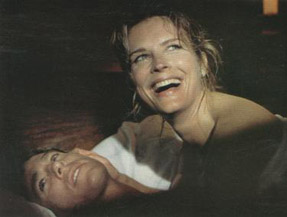Chapter Two:
Oliver's Story and Class of '44
By Brett Ballard-Beach
March 15, 2012
In Love Story, the couple is Oliver and Jennifer, verbally sparring college sweethearts who wind up married, only to be separated by the Grim Reaper when she succumbs in her mid-20s to an unnamed disease (specified as leukemia in a reference to her death in Oliver’s Story.) There is very little else to the story aside from their love (and his attempt to earn his wealthy industrialist father’s respect), but Ryan O’Neal and Ali McGraw are everything that a screen couple should be and evenly matched in looks, causticity, self-deprecation, and wounded glances.
In Summer of ’42, the man (or rather boy) and woman are one-time-only lovers: she, Carol, a 22-year-old recent war widow and he, Hermie, a high-schooler vacationing for the season with his family and two best friends on Nantucket. The ick factor (in spite of Jennifer O’Neill’s gentle and non-predatory demeanor) and one’s mind wandering towards charges of statutory rape are theoretically supposed to be alleviated by its being set in a “simpler time” and the fact that Raucher penned nearly all the events and characters verbatim from his life. But the brief narration, voiced by the author, and the “fly set in amber” tone that the film strikes from the very beginning via its bathos-stalgic main theme and color-desaturated still photographs left me uneasy throughout. There are only a handful of characters aside from the three boys and Carol, and nothing else to the story aside from the young men’s fixation on getting laid and what to do before, during, and after getting laid, so the prevailing tone is something like Porky’s dressed up in a bittersweet chamber piece’s garments.
In the case of Oliver’s Story and Class of ‘44, neither project was an initiative driven on the studio’s part. Segal wrote a follow-up novel and Raucher another screenplay, each which were individually optioned. Class of ’44 arrived in the spring of 1973, accompanied by a novelization by Madeline Shaner, while Oliver’s Story showed up in late 1978, about a year after the book’s release. And as different as both are in most ways, and in their levels of entertainment, I find it intriguing that the resolution of a father-son relationship plays a significant role in the conclusion of both, especially in the film where such a resolution comes as a jarring surprise and delivers no emotional catharsis whatsoever.
Class of ’44 is the more abrupt in its tonal shift from its predecessor, so I will begin there. While the first felt in its broad strokes like it had some of the DNA of a French coming-of-age film, and was distinguished by its mix of emotional isolation and randy teen male hormones, the sequel is like Animal House tamed down for the PG set. To put it another way, if Summer of ’42 made me uneasy in the way it seemed to have been directly splashed onto the screen wholesale from someone’s life, Class of ’44 feels as generic and artless as a Norman Rockwell knock-off done by someone whose previous artistic bent was submitting Tippy the Turtle sketchings to the Art Instruction Schools that advertised on matchbooks and in the back pages of comic books. It’s not a terrible sketch but it rarely seems to have the perspective of even two dimensions. I have seen almost nothing else by director Paul Bogart, but his installment in the Oh God! Series - the third and final feature Oh God! You Devil with George Burns both heavenly and hellish - was a childhood favorite of mine on video in the mid-‘80s.
Continued:
1
2
3
4
5
|
|
|
|

![]() Tweet
Tweet
![]() Print this column
Print this column



